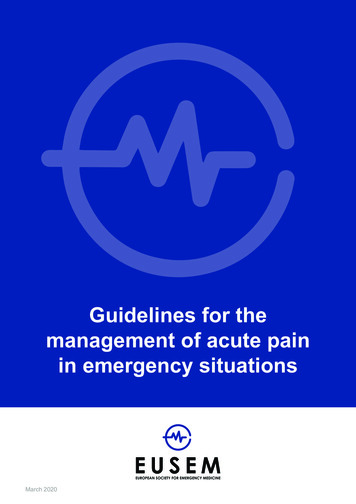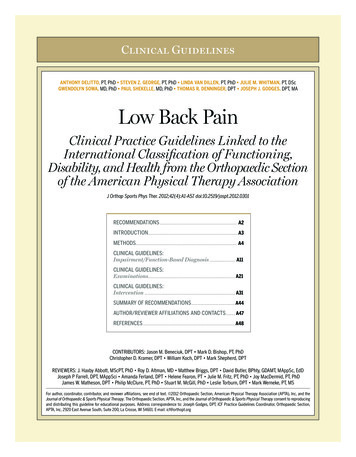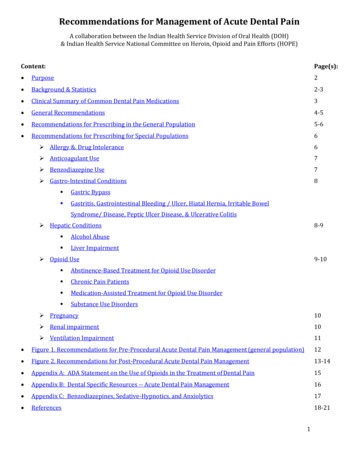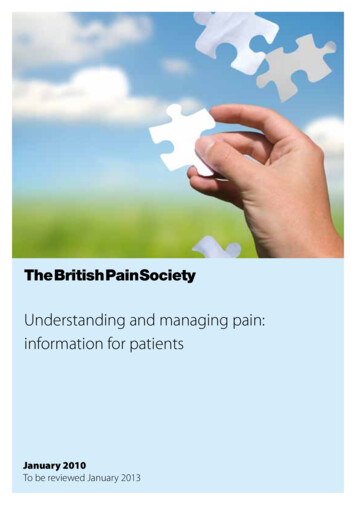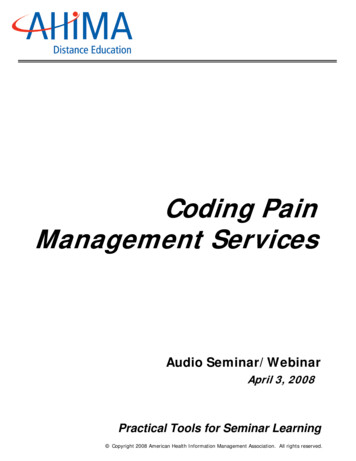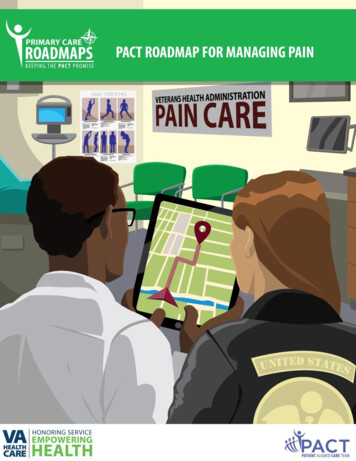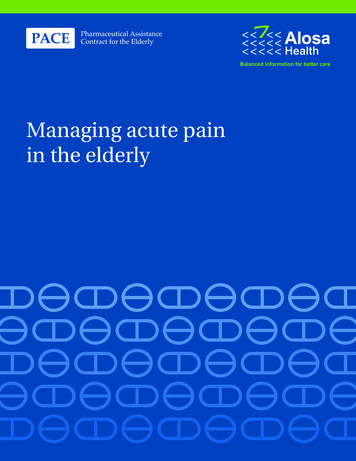
Transcription
Balanced information for better careManaging acute painin the elderly
Managing acute pain in the elderlyPrincipal Consultants: Brian Bateman M.D., M.Sc.Series Editors: Jerry Avorn, M.D. (principal editor), Dae Kim, M.D., M.P.H., Sc.D., Jing Luo, M.D., M.P.H.,Niteesh K. Choudhry, M.D., Ph.D., Michael Fischer, M.D., M.S., Gregory Curfman, M.D.; Ellen Dancel,PharmD, M.P.H.Medical Writer: Jenny CaiThis document was produced by The Independent Drug Information Service (IDIS) of AlosaHealth, supported by the Pharmaceutical Assistance Contract for the Elderly (PACE) Program ofthe Department of Aging of the Commonwealth of Pennsylvania.Alosa Health is a nonprofit organization which is not affiliated with any pharmaceutical company.None of the authors accepts any personal compensation from any pharmaceutical manufacturer.These are general recommendations only; specific clinical decisions should bemade by the treating physician based on an individual patient’s clinicalcondition. 2018 Alosa Health. All rights reserved. For more information, see AlosaHealth.org.
ii Managing acute pain in the elderly
Alosa HealthManaging acute pain in the elderlyAccreditation:This activity has been planned and implemented in accordance with the accreditation requirements andpolicies of the Accreditation Council for Continuing Medical Education through the joint providership ofHarvard Medical School and Alosa Health. The Harvard Medical School is accredited by the ACCME toprovide continuing medical education for physicians.Credit Designation:The Harvard Medical School designates this enduring material for a maximum of 1.50 AMA PRA Category 1Credits . Physicians should claim only the credit commensurate with the extent of their participation in theactivity.Activity Overview:The primary goal of this educational program is to address the need for safe, effective pain relief amongolder adults across a range of settings. Achieving functional goals without posting harm from side effects,addiction, or potential overdose is challenging in this patient population due to such issues as alteredpharmacodynamics/pharmacokinetics with age; polypharmacy; potential cognitive deficits; and heightenedrisk of falls and organ-specific vulnerabilities.The educational program has several components, which include: Written evidence report (print monograph) Summary document of top 4-5 key messages “Academic detailing” educational sessions in physicians’ offices with trained outreach educators(pharmacists, nurses, physicians) who present the material interactively Reference cards for easy access to key materials Patient education information (brochure/tear off sheets)This program works to synthesize the current clinical information on this topic into accessible, noncommercial, evidence-based educational material, which is taught interactively to providers by speciallytrained clinical educators.Target Audience:The educational program is designed for primary care physicians practicing internal medicine, primary care,family practice, and geriatrics, and other health care professionals who deliver primary care.Learning Objectives:Upon completion of this activity, participants will be able to: Consider all treatment options to manage pain for different types of acute pain conditions, optimizingthe use of non-opioid alternatives before considering opioids. Explain the evidence supporting the efficacy and risks of different treatment options for acute pain. Follow several general principles for prescribing opioids for acute pain if opioids are necessary. Establish realistic expectations for patients to reduce their concerns about their acute pain andcontain demands for addictive analgesics.Managing acute pain in the elderly iii
Optimize a multimodal pain management strategy for acute pain by combining several approaches,including non-pharmacologic and non-opioid pharmacologic options. Develop a strategy to identify patients with possible opioid use disorder or problematic behaviors andprovide or refer to appropriate care. Recommend naloxone for at-risk patients.Disclosure Policy:Harvard Medical School has long held the standard that its continuing medical education courses be free ofcommercial bias.In accord with the disclosure policy of the Medical School as well as standards set forth by the AccreditationCouncil for Continuing Medical Education, course planners, speakers, and content reviewers have beenasked to disclose any relevant relationship they, or their spouse or partner, have to companies producing,marketing, re-selling or distributing health care goods or services consumed by, or used on, patients. Inaddition, faculty have been asked to list any off-label uses of pharmaceuticals and/or devices forinvestigational or non-FDA approved purposes that they plan to discuss. Such disclosure is not intended tosuggest or condone bias in any presentation, but is elicited to provide the course director and participantswith information that might be of potential importance to their evaluation of a given presentation.Disclosures:This material is provided by Alosa Health, a nonprofit organization which is not affiliated with anypharmaceutical company. No commercial support has been received for this activity. All individuals includingplanners, authors, reviewers, academic detailers, staff, etc., who are in a position to control the content ofthis educational activity have, on behalf of themselves and their spouse or partner, reported no financialrelationships related to the content of this activity. The Independent Drug Information Service (IDIS) issupported by the PACE Program of the Department of Aging of the Commonwealth of Pennsylvania.Faculty and Planners:Brian Bateman, M.D., M.Sc., is an Associate Professor of Anesthesia at Harvard Medical School. He is theChief of the Division of Obstetric Anesthesia in the Department of Anesthesiology, Perioperative and PainMedicine, and is a researcher in the Division of Pharmacoepidemiology and Pharmacoeconomics,Department of Medicine, both at Brigham and Women’s Hospital. Dr. Bateman has no relevant financialrelationships to disclose.Jerry Avorn, M.D., is a Professor of Medicine at Harvard Medical School and Chief of the Division ofPharmacoepidemiology and Pharmacoeconomics at Brigham and Women's Hospital. An internist, he hasworked as a primary care physician and geriatrician and has been studying drug use and its outcomes forover 35 years. Dr. Avorn has no relevant financial relationships to disclose.Dae Kim, M.D., M.P.H., is an Assistant Professor of Medicine at Harvard Medical School and a geriatrician atBeth Israel Deaconess Medical Center. Dr. Kim has no relevant financial relationships to disclose.Jing Luo, M.D., M.P.H., is an Instructor in Medicine at Harvard Medical School and an urgent care providerat the Brigham and Women’s Hospital. His research focuses on prescription drug pricing and pharmaceuticalregulation. Dr. Luo has no relevant financial relationships to disclose.iv Managing acute pain in the elderly
Niteesh K. Choudhry, M.D., Ph.D. is a Professor of Medicine at Harvard Medical School and a hospitalist atBrigham and Women's Hospital. His research focuses on the use of medications to treat common chronicconditions. Dr. Choudhry has no relevant financial relationships to disclose.Michael Fischer, M.D., M.S., is an Associate Professor of Medicine at Harvard Medical School and a primarycare internist who studies cost–effective drug use in outpatient practices. Dr. Fischer has no relevantfinancial relationships to disclose.Gregory Curfman, M.D., is an Assistant Professor of Medicine at Harvard Medical School and board-certifiedinternal medicine physician and cardiologist. Dr. Curfman has no relevant financial relationships to disclose.Ellen Dancel, Pharm.D., M.P.H., is the Director of Clinical Materials Development at Alosa Health. Dr.Dancel has no relevant financial relationships to disclose.Jenny Cai, M.Sc., is a medical writer and curriculum specialist with over eight years of experience in medicaleducation. Ms. Cai has no relevant financial relationships to disclose.ReviewersChris Gilligan, M.D., is an Assistant Professor of Anesthesiology at Harvard Medical School and Chief of theDivision of Pain Management, Department of Anesthesiology, Perioperative and Pain Medicine at Brighamand Women’s Hospital. Dr. Gilligan has no relevant financial relationships to disclose.Don Teater, M.D., M.P.H., is a family physician and principal of Teater Health Solutions. He previously heldthe role of Medical Advisor with the National Safety Council, where he worked to reduce death and injuryfrom prescription opioid overdose. Dr. Teater has no relevant financial relationships to disclose.Susan O’Brien is a CME Consultant and CME reviewer for Harvard Medical School Department ofContinuing Education. Her role is to review CME proposals for compliance with regulatory requirements. Ms.O'Brien has no relevant financial relationships to disclose.The following committee members from Harvard Medical School’s Continuing Medical Education programalso reviewed this educational activity: Gyorgy Baffy, M.D., Ph.D.; James Burnes, M.D.; Laura Collins, M.D.;Louis Pasquale, M.D.; Jane Sillman, M.D.; and Mary Lou Townsend, M.Ed. Dr. Pasquale is a paidconsultant for Bausch & Lomb, an unpaid consultant for Novartis, and a speaker for Allergan. He is therecipient of a grant from NEI and the recipient of an unrestricted grant from Merck. None of the othercommittee members have any relevant financial relationships to disclose.Media used:Printed educational material.Instructions for Participation and Credit:There are no fees to participate in this activity. To receive credit, participants must (1) read the statementson target audience, learning objectives, and disclosures, (2) study the educational activity, and (3) completethe post test and activity evaluation. To receive AMA PRA Category 1 Credit , participants must receive aminimum score of 70% on the post test.Tests and evaluations should be submitted to Alosa Health via email, mail or fax.Managing acute pain in the elderly v
Email: cme@alosahealth.orgMailing address:Alosa Healthth419 Boylston Street, 6 FloorBoston, MA 02116Fax: 857-350-9155The activity will take approximately 1.50 hours to complete.Activity publication date: May 8, 2018Termination date: May 8, 2021Please email any questions to cme@alosahealth.org or call (617) 948-5997.vi Managing acute pain in the elderly
Table of ContentsScope of acute pain in the elderly . 1Defining acute and chronic pain . 2Assessing acute pain . 2Assessing pain intensity . 2Assessing pain in patients with cognitive impairment . 3Managing acute pain . 4Managing patient expectations . 5Challenges in managing acute pain in the elderly . 6Selecting a pain regimen . 7Risks of prescription opioids . 8Opioids for severe acute pain . 13Acute pain conditions . 18Acute low back pain . 18Post-operative pain . 25Sprains, strains, fractures, and trauma . 31Acute pain management in special populations . 37Chronic opioid users . 37Patients on opioid agonist maintenance therapy . 38Patients with history of opioid addiction or dependence (off medication assisted treatments) . 39Putting it all together. 40Appendix I: Brief Pain Inventory . 41References . 43Managing acute pain in the elderly vii
viii Managing acute pain in the elderly
Scope of acute pain in the elderlyOlder patients are at increased risk of pain from degenerative conditions such as osteoarthritis, and oftenexperience pain in multiple sites, compounding pain-related suffering and disability. As the elderly undergosurgery four times more often than other age groups, they are also more likely to suffer from the pain1consequences of surgery.2Generalized pain increases in intensity with age. Acute pain in particular is a common reason foremergency department (ED) visits among older adults. In those 65 years and older, acute pain leads to3about 4 million U.S. emergency department (ED) visits each year. Potential barriers to assessing andaddressing pain during ED visits include cognitive and functional impairments, as well as limitations ofphysician knowledge about how to address pain in older patients . As a result, many elderly patientsexperience higher rates of pain and lower rates of effective treatment at the end of the ED visit, and are 20%4less likely to receive treatment than younger adults.In addition to inadequate pain relief, unaddressed acute pain may lead to poorer clinical outcomes, includingbehavioral problems, longer hospital stays, impaired mobility, complications, as well as the development or4,5intensification of delirium. Effective management of acute pain can facilitate patient treatment andrecovery, and in some cases, may help prevent chronic pain. In particular, effective early treatment of older6adults with acute pain can lead to reduced persistent pain and better long-term function.Assessment of pain in older patients is often complicated by issues such as age-related physiologicchanges, physical accessibility to treatment, psychosocial concerns, frailty, poor memory, coexistingillnesses, use of concomitant medication, and problems of communication with patients with cognitiveimpairment. Elderly patients may often under- or over-report their experience of pain due to functionalimpairment or psychological distress. Clinical decision-making must take into account all of theseconsiderations, each of which can increase the risk for adverse outcomes. Opioids are often used to provideacute pain relief but have addictive and euphoric properties that can lead to adverse effects, misuse, abuse,addiction, and overdose. In addition to being bothersome, opioid side effects can also contribute to reducedquality of life and substantial morbidity. Awareness of best practices surrounding opioid use in the elderly is7essential to effective acute pain care.Due to the high prevalence of acute pain, clinicians are challenged with providing effective pain relief whileminimizing side effects in this unique population. In particular, opioids are often relied upon to provideadequate relief for acute pain but have addictive and euphoric properties that make patients vulnerable tomisuse, abuse, addiction, and overdose. Opioids are also associated with significant adverse side effects. Inaddition to being bothersome, these side effects can also contribute to reduced quality of life and substantialmorbidity, as older adults are more likely to miss doses, overuse opioids, discontinue treatment, or have lowcompliance. Awareness of best practices surrounding opioid use in the elderly is essential to effective acute7pain care.This evidence document outlines the core principles of acute pain management in the elderly population,with special considerations for the safe, effective and responsible use of prescription opioids. It also reviewsevidence for three common pain syndromes common in older adults: acute low back pain, post-operativepain, as well as sprains, strains, fractures and trauma (acute musculoskeletal pain). Finally, it offersrecommendations on the management of acute pain in patients who use opioids on a long-term basis forManaging acute pain in the elderly 1
chronic pain, and the management of acute pain in those with opioid use disorder (formerly referred to asaddiction).Defining acute and chronic painAcute pain is defined as having an abrupt onset and is due to an obvious cause, such as an injury or otherprocess that is not ongoing, such as a recent surgical procedure. It has a generally short duration, and8usually lasts less than four weeks, improving over time. Acute pain is one of the most common presenting9complaints in ambulatory care.In contrast, chronic pain is defined as pain that typically lasts more than three months or past the time ofnormal tissue healing. It can be the result of an underlying medical disease or condition, injury, medical10treatment, inflammation, or an unknown cause. Chronic pain is addressed in a separate Alosa Healthmodule.Although pain is expected after injury or surgery, the patient pain experience can vary markedly. Theintensity of pain can be influenced by psychological distress (depression/anxiety), heightened illness11concern, and ineffective coping strategies regarding the ability to control pain and function despite it. It mayalso be shaped by personality, culture, attitudes and beliefs. For example, injured soldiers who had positiveexpectations of pain (e.g., evacuation and safe recuperation) requested less analgesic medication thancivilians with comparable injuries who had more negative associations with pain (e.g., loss of wages and8social hardship).Assessing acute painAppropriate pain management includes a comprehensive initial assessment, as well as frequentreassessments of treatment response. Such assessments include evaluation of pain intensity location,12,13quality and duration, aggravating or alleviating factors, and previous treatments and their efficacy.Thecomplexity of pain assessment in geriatric patients often requires a multimodal approach to diagnosis andmanagement.The physical examination includes a complete musculoskeletal examination of the primary site of pain, withparticular attention to common conditions such as fibromyalgia, osteoarthritis, and myofascial pain. Types ofpain include nociceptive (pain due to tissue injury), neuropathic, and undetermined (multiple etiologies).Older adults are more likely to experience neuropathic pain compared with younger adults because many14diseases that cause neuropathic pain increase in incidence with age. Types of neuropathic pain includediabetic neuropathy, postherpetic neuralgia, trigeminal neuralgia, and post-stroke pain. Each of these maybe characterized by hypersensitivity, paresthesia, spontaneous (not stimulus-induced) ongoing pain, and15shooting, electric shock-like sensations.Assessing pain intensityRegular evaluation using a pain scale allows the physician to monitor treatment effectiveness and todetermine when changes are needed. It is important to be consistent with evaluations and to use the samescale during follow-up examinations. Generic unidimensional pain questionnaires include the Visual AnalogScale (VAS) and Numeric Rating Scale (NRS), simple measures in which patients rate their current pain16intensity from 0 (“no pain”) to 10 (“worst possible pain”). The widely used Wong-Baker FACES Pain Rating2 Managing acute pain in the elderly
Scale includes a numeric rating scale accompanied by a series of faces depicting various levels of pain(Figure 1).Figure 1: Wong-Baker FACES Pain Rating ScaleWhile useful for a quick assessment of pain, these scales alone may not appropriately identify patients withpain-related suffering driven by functional limitations, worry, or other factors, and may not detect some17patients with clinically significant pain. In elderly patients, the VAS is associated with more responses that13are incomplete or unable to be scored.Multidimensional pain questionnaires include the Short-form McGill Pain Questionnaire, Chronic Pain GradeScale, and Short Form 36 Bodily Pain Scale, which assess more aspects of pain, but are mainly used toassess chronic pain rather than acute pain.Asking the patient to point to the body part that hurts can be useful in cognitively impaired older adults. Painmaps have been used among adults of all ages with both acute and chronic pain and have been effectively18used with cognitively impaired elderly patients in long-term care facilities.Although developed for patients with chronic pain, the Brief Pain Inventory (BPI) is also applicable to patientswith acute pain. Completed by the patient, the BPI more fully captures impact of pain on function and qualityof life than unidimensional questionnaires, although, like most multidimensional questionnaires, it requires19more time (10 minutes) and concentration to complete, which may limit its utility in some elderly patients.See Appendix I for a sample of the BPI.Assessing pain in patients with cognitive impairmentSelf-reports are the most reliable source of information on pain, but if a patient cannot do this adequatelybecause of cognitive impairment or dementia, caregiver’s reports can be used. Patients with severedementia may be unable to report or describe pain, nor request analgesia. Language deficits are a major20barrier to adequate pain assessment and treatment in the elderly.Symptoms of delirium can overlap with manifestation of pain in older patients. In some cases, poorlycontrolled pain may even precipitate delirium or behavioral changes in patients with cognitive impairment,20and increase symptoms such as fast or loud speech, irritability, persistent thoughts, anger, or lethargy. In aprospective observational study in 361 patients who had undergone elective non-cardiac surgicalprocedures, higher pain scores at rest were associated with an increased risk of delirium over the first threeManaging acute pain in the elderly 3
days after surgery (adjusted risk ratio 1.20, p 0.04), although pain with movement and maximal pain score5showed no effect.Careful observation of pain behaviors may be helpful to determine whether there is a treatable cause of pain.For example, the Pain Assessment Checklist for Seniors with Severe Dementia (PACSLAC) is a checklist of20six pain behavioral categories: facial expressions (grimacing, closed eyes, rapid blinking)verbalization (moaning, calling out, verbal abusiveness)body movement (guarding, fidgeting, gait changes)changes in interpersonal interaction (combativeness)changes in activity patterns or routines (cessation of common routines)changes in mental status (confusion, irritability)BOTTOM LINE: Assessing acute pain in the elderly can be challenging, and requires the use ofvalidated instruments, caregiver reports, as well as a thorough history and examination.Managing acute painIt is important to find the right balance between undertreating acute pain and over-medicating for a selflimited condition. In many cases, the cause of a patient’s pain is benign, and the most effective treatmentmay simply be to provide reassurance to the patient and wait for the underlying condition to improve on itsown. In part to address patient concerns or worry, providers may provide too much care, such asunnecessary imaging for uncomplicated acute low back pain, other unneeded diagnostic procedures orsurgeries, and prescribing more medication than necessary.However, in other cases, clinicians may not do enough to treat pain, often leading to missed or delayeddiagnosis and management of underlying conditions. Insufficient post-operative pain control may precipitatedelirium, especially in the elderly. Therefore, it is important to adequately address acute pain while avoidingover-treatment. The rapid and effective management of acute pain may reduce or prevent adversephysiologic and psychological consequences associated with pain progression, including stress escalation,21progression to chronic pain, or inability to comply with medical interventions.4 Managing acute pain in the elderly
Figure 2: Finding the right balance in management of acute painThe goal of optimal pain treatment is not to eliminate pain, but rather to relieve suffering and improvefunction while minimizing the harms and risks associated with treatment. Timely adjustments intreatment for inadequately controlled pain can facilitate recovery from underlying diseases or injuries.Managing patient expectationsOne long-standing rule of thumb states that 90% of patients experience a 90% improvement in pain by 90days. While not quantitatively rigorous, this concept has some support in the literature. Most forms of acutenociceptive pain (e.g. nonspecific low back pain) are self-limited, subside within weeks, and do not requiresubstantial intervention. In a systematic review evaluating 15 prognosis trials, 82% of people who stopped22work due to acute low back pain returned to work within one month. (See Low Back Pain section beginningon p18 for more information on relevant studies).In a prospective observational study of 1633 patients with acute low back pain, patients showed rapidimprovement after the onset of low back pain, with a mean of 16 days to return to a functional status similar23to that before onset. Only 5% of patients had not reported functional recovery at six months.Helping patients manage expectations can reduce fear, worry, concern, and distress, as well asexcessive demands for medication. A systematic review of 14 controlled trials of patient educationinterventions for low back pain showed that structured messaging can reassure patients with acute painmore than usual care/control education both in the short and long term. Messaging was significantly morereassuring to patients when delivered by physicians than other primary care practitioners, and such24communication can reduce the frequency of primary care visits. In treating is self-limiting acute pain, suchreassurance by physicians is an essential aspect of management.Examples of effective messaging evaluated in clinical studies: “Based on the history and exam, you have a good prognosis.” “The acute pain you are experiencing is benign.” “Avoid bed-rest.”Managing acute pain in the elderly 5
Challenges in managing acute pain in the elderlyThe clinical approach to acute pain assessment and management differs in older versus youngerpopulations. Elderly patients often have diminished functional status and physiological reserve, with a higherpotential to develop complications and adverse reactions to medication than the general public. Concurrentillnesses and conditions may complicate treatment of pain, as patients are more likely to be on severalmedications at once. In addition, age-related changes in elderly patients result in increased fat mass,decreased muscle mass, and decreased body water compared to the general population; this can have25important pharmacodynamic implications for drug dosage and toxicity.The elderly are at the highest risk for functional decline, medical and surgical complications, and opioid6related side effects. Delirium is the most common post-operative complication in older persons and isassociated with adverse clinical and economic outcomes, such as higher rates of major complications, poor26functional recovery, increased length of hospital stay, and higher costs.Opioid use can increase the risk of delirium. A prospective cohort study monitored exposure to medicationswith psychoactive properties such as opioids, benzodiazepines, and anticholinergics in 91 post-operativepatients who developed delirium after surgical procedures and 154 controls. All opioids can cause delirium;no significant differences in the rates of delirium have been found among other commonly used opioids, suchas morphine, fentanyl, tramadol, hydromorphone, or oxycodone. However, a greater risk of delirium wassignificantly associated with post-operative use of meperidine (OR 2.7; 95% CI: 1.3-5.5) andbenzodiazepines (OR 3.0; 95% CI: 1.3-6.8). For benzodiazepines, long-acting agents and high-dose26,27exposures were more likely to cause delirium than short-acting agents or low-dose exposures.In view of this evidence, clinicians caring for patients at risk for delirium (such as the elderly) should carefullyevaluate the use of all psychoactive medications in the post-operative period (e.g., benzodiazepines),choose the lowest effective dose of opioids for a short duration, and employ alternative therap
In addition to inadequate pain relief, unaddressed acute pain may lead to poorer clinical outcomes, including behavioral problems, longer hospital stays, impaired mobility, complications, as well as the development or intensification of delirium.4,5 Effective management of acute pain can facilitate patient treatment and


